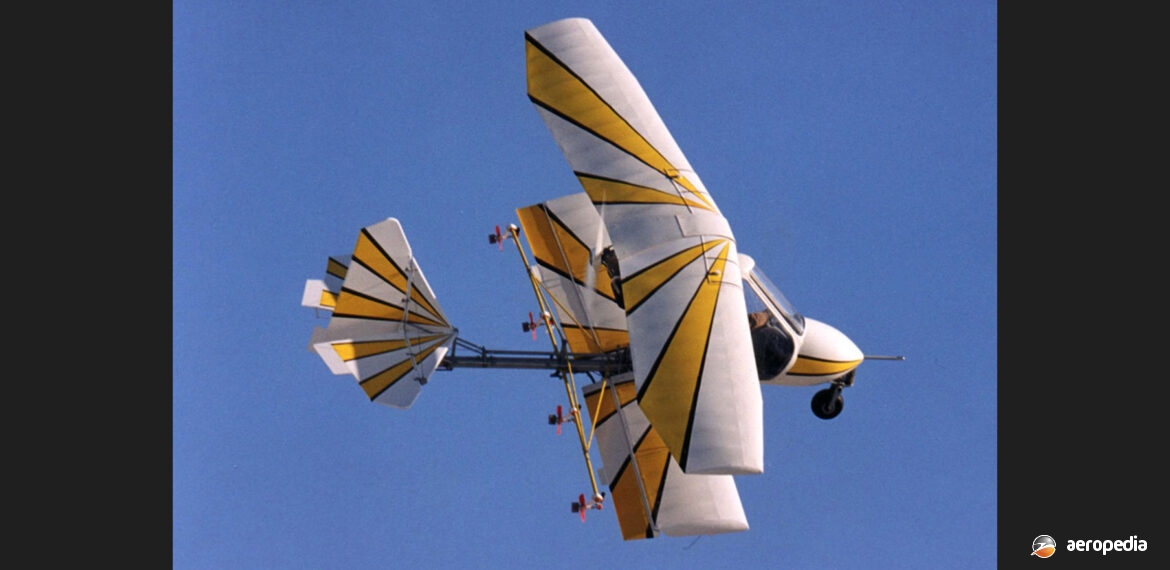Photograph:
Aviatika MAI-890 SHK during testing in Russia (Aviatika)
Country of origin:
Russia
Description:
One or two-seat light multi-purpose biplane
Power Plant:
One 48 kw (64 hp) Rotax 582UL two-cylinder, two-stroke, air-cooled engine
Specifications:
- Wingspan (upper): 8.11 m (26 ft 7½ in )
- Length: 5.32 m (17 ft 5½ in)
- Height: 2.25 m (7 ft 4¾ in)
- Wing area: 14.29 m² (153.8 sq ft)
- Max speed: 140 km/h (87 mph)
- Cruising speed: 120 km/h (74 mph)
- Max rate of climb at sea level: 336 m/min (1,102 ft/min)
- Service ceiling: 5,500 m (18,045 ft)
- Max range with standard fuel: 270 km (167 miles)
- Range with auxiliary tank: 550 km (340 miles)
- Endurance: 3 hours
- Empty weight: 215 kg (474 lb)
- Loaded weight: 450 kg (992 lb)
History:
Design of the Aviatika MAI-890 began in 1989 in Moscow, Russia, the prototype flying for the first time in the following year, delivery of production aircraft commencing to be delivered in 1991. The aircraft was designed for a number of roles, versions current during 1994 being the MAI-890 single-seat; MAI-890U two-seat; and the MAI-890 Farmer for agricultural use.
The design was a strut and wire-braced biplane with the engine mounted under the trailing-edge of the upper wing, there being slight sweepback on all wings. Being semi-aerobatic in capability, the aircraft was capable of flying in rough air conditions. In the MAI-890 Farmer model the agricultural equipment added 28 kg (62 lb) to the weight, chemicals to a total of 60 kg (132 b) being able to be loaded when the Rotax 582 engine was fitted. Structure was of aircraft grade aluminium and titanium alloys with fabric covering. A 37 kw (50 hp) Rotax 503UL or the 60 kw (80 hp) Rotax 912 engine were optional, and later the Rotax 912ULS of 75 kw (100 hp) was installed.
Production of the series continued, one being employed on geo-video monitoring and soil parameters definition. It was a wire-braced aircraft with fabric covered wings, control surfaces and tail units, with a tricycle fixed undercarriage and controllable nose-wheel. The fuselage was made from aluminium tube, the cockpit being fully enclosed with two doors, glazing was made from organic glass, and a nose fairing was constructed from fibreglass. The beams of the wings were made from aluminium tubes, the ribs being pressed from aluminium alloy. It was produced by the Federal State Unitary Enterprise Russian Aircraft Corp, MiG, which also produced the Mikoyan and Gurevich MiG-29 fighter. It was designed in accordance with JAR VLA and FAR-23 regulations and has been certified in Russia, South Africa and France.
In October 1993 an MAI-890 (c/n 053) was registered as VH-CLM² to Scone Aircraft Maintenance, NSW . Obtained by David Reid and Colin Pay, it was flown from Canberra, ACT to Scone. It was a well constructed machine purpose built in a Russian aircraft facility, but did not meet CASA requirements and in the end was struck off the register in May the following year.
The aircraft was sold to a pilot in the Hunter Valley, NSW who eventually took it up to the Gulf of Carpentaria, QLD. It was removed from the Australian Civil Aircraft Register on 27 May 1994 and became 19-3869 on the RAA register at that time. It was described as a Meddings MA-189OU, registered to Steven Meddings. A wing was damaged and a replacement was obtained from Russia. At some stage it was re-engined with an uprated model Rotax. The registration expired on 4 February 2002 and the ultimate fate of the aircraft is not known.

